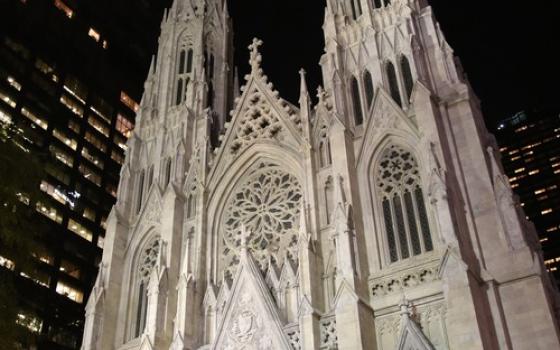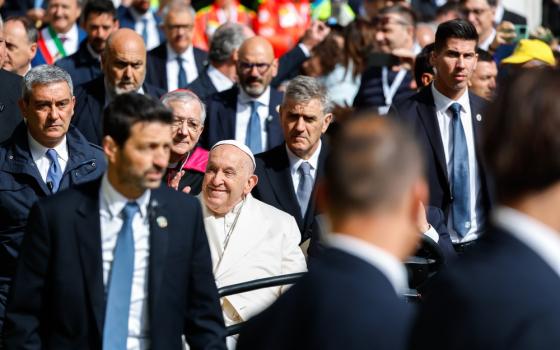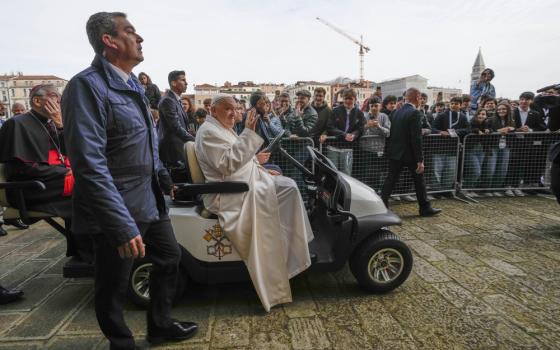COMPLICITY IN THE HOLOCAUST: CHURCHES AND UNIVERSITIES IN NAZI GERMANY
By Robert P. Ericksen
Published by Cambridge University Press, $27.99
Professor Robert Ericksen is a Germanist historian who has spent some 30 years studying the role of the churches under the Nazis. His broad-brush treatment of the main German Christian denominations and the universities in this new work accords with the familiar view that the majority of pastors and teachers went along with the regime. He demonstrates, moreover, that their acquiescence was not so much for fear of the consequences of resistance, nor in support of Nazi ideology, but a tendency to drift with the tide.
For a Catholic reader, Ericksen’s study is of particular interest for his assessment of Eugenio Pacelli, the future Pius XII. Pacelli spent 13 years in Germany as nuncio from 1917 until being appointed cardinal secretary of state in 1930. An ailing Pius XI delegated to him the handling of German affairs. By the beginning of the war in 1939, Pacelli had been elected pope.
Pacelli is currently headed for beatification, and his devotees have been hard at work defending his reputation against allegations that he did not do enough to condemn the Holocaust. The danger of authentic papal history degenerating into hagiography is real and present; hence the independent viewpoint of historians like Ericksen is valuable.
 On the Vatican’s early dealings with Adolf Hitler, Ericksen focuses on the negotiations for the Reichskonkordat, the international agreement between Hitler and Holy See, which began in March 1933 and concluded in July of that year. The treaty, which involved the German hierarchy agreeing to withdraw from all social and political action, was negotiated at the highest level between Hitler personally (through Franz von Papen, his vice chancellor) and Pacelli on behalf of Pius XI. Pacelli successfully negotiated not only greater control of Catholic schools by the bishops, but more places, teachers and school buildings. Ericksen notes that Hitler was meanwhile pushing through his Jewish business boycott and the Law for the Cleansing and Restoration of the German Civil Service. These measures meant the reduction of pupil and student places for Jews, and the nationwide expulsion of Jewish teachers, academics and scientists.
On the Vatican’s early dealings with Adolf Hitler, Ericksen focuses on the negotiations for the Reichskonkordat, the international agreement between Hitler and Holy See, which began in March 1933 and concluded in July of that year. The treaty, which involved the German hierarchy agreeing to withdraw from all social and political action, was negotiated at the highest level between Hitler personally (through Franz von Papen, his vice chancellor) and Pacelli on behalf of Pius XI. Pacelli successfully negotiated not only greater control of Catholic schools by the bishops, but more places, teachers and school buildings. Ericksen notes that Hitler was meanwhile pushing through his Jewish business boycott and the Law for the Cleansing and Restoration of the German Civil Service. These measures meant the reduction of pupil and student places for Jews, and the nationwide expulsion of Jewish teachers, academics and scientists.
Ericksen fails, however, to stress a fateful moral connection. The German Catholic church, led from the front by Pacelli, was accepting ample benefits from the same source of power that was denying a range of social provisions, not least educational, to Jews.
A wide range of recent historical reflection on the Nazi period defines the predicament of those who received benefits from the tyrant, while remaining aloof ideologically, as that of the Mitlaüfer, fellow traveler. Historians have argued that German fellow-travelers among churchmen, judges and academics did more damage than card-carrying Nazi adherents. Fellow-traveling, they maintain, demoralized the opposition, scandalized the young, and gave comfort to the regime.
Recognizing the calamitous consequences of the Reichskonkordat, church historian Klaus Scholder and others have drawn attention to Hitler’s boast in cabinet in July 1933 that the treaty had given the Nazi regime credibility in the eyes of the world. For Pacelli, writing during the same week in the L’Osservatore Romano, the success of the treaty was the recognition by Hitler of the 1917 Code of Canon Law.
Pacelli’s aim in Germany during the 1920s had been precisely to bring the new canon law code (not least the decree that only the pope should nominate new bishops) into line with a new Reichskonkordat. Where Pacelli had failed with five Catholic chancellors, he reached agreement with Hitler within four months. The notion that Pacelli had sought the treaty purely to defend Catholic freedoms is therefore not entirely true.
No churchman found Hitler and Nazism more despicable than Pacelli, but it is surely crucial to understand the power politics that led Pacelli to accept benefits from Hitler, or, as Pius XI would put it, sup with the devil. Pope John Paul II’s refusal to countenance concordats with the communists may well have been based on his recognition of the dangers of fellow-traveling with the Nazis.
On the issue of Pacelli’s silence during the war, Ericksen believes that the jury is still out until the entire wartime archive is released for study. As I acknowledged in my 2009 edition of Hitler’s Pope: The Secret History of Pius XII, I am even more convinced, in the light of recent evidence, that he saw the danger of greater suffering for Jews and Catholics should he have spoken out. All the same, I would maintain that since his silence had given scandal, it was surely incumbent on him to explain his reticence when the pressures were lifted. This he never did.
Ericksen casts doubt, moreover, on claims that Pacelli saved hundreds of thousands of Jewish lives. He is not alone in suspecting that Pacelli’s hagiographers are giving him credit for deeds of courage performed by individuals lower down the hierarchal scale.
Enthusiasts’ appropriation of credit for Pacelli on this score may well prove hostage to historical scholarship’s fortunes in the long term. In any case, if Pacelli is to be praised for harboring many genuine refugees during the war, he should surely, by the same token, be held responsible for protecting the Nazi rat-run fugitives after the war. I suspect that credit for the former, and blame for the latter, are greatly exaggerated.
[John Cornwell is the author, most recently, of Newman’s Unquiet Grave: The Reluctant Saint.]



